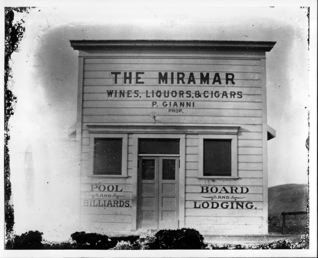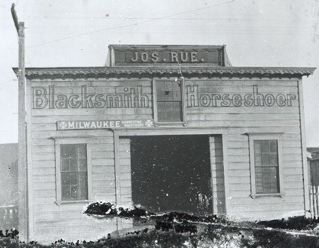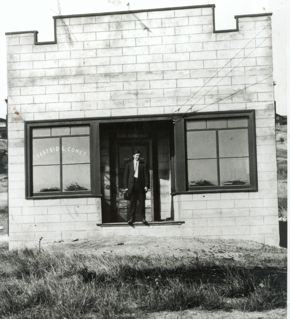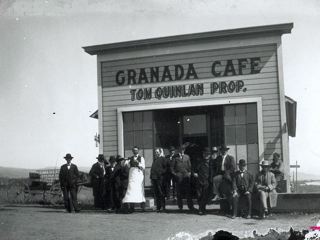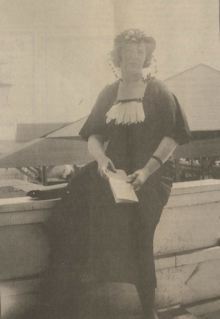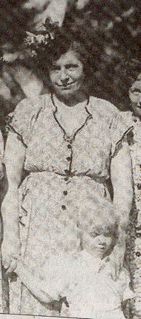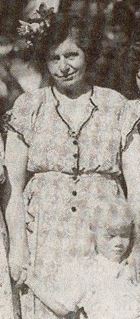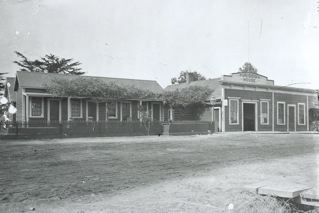The Coastside Newspaper Office
I Hear From Frank Hillman, a [Herbert] Hoover “Jr. Hi” Classmate
Photo: At right, Frank Hillman fooling around with friend Ron Bryant–jr hi days.
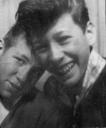 Thats an even bigger surprise! You still have that picture of Ron and myself. . That is Great!! I guess what happened to me was i went to Poly along with John Alexander and a few others from Hoover. I always thought i got cheated –leaving all my friends having to go to Poly. Still enjoyed it but always missed the West Portal and Hoover classmates.
Thats an even bigger surprise! You still have that picture of Ron and myself. . That is Great!! I guess what happened to me was i went to Poly along with John Alexander and a few others from Hoover. I always thought i got cheated –leaving all my friends having to go to Poly. Still enjoyed it but always missed the West Portal and Hoover classmates.
I live in SF (Noe Valley) Have 2 grown daughters. Worked at S&C Ford for many years. One of my neighbors in Rodney May. I think its fantastic that you all remained close contact
with many of the girls. How about the guys?? I still have my West Portal School class pictures from 58,59, and 60. If you do not and would like copies i can make a few . Thanks again for the picture…Frank
The Inez Burns Story, Part XVIIII: Conclusion!
Inez Burns soon learned that she had been framed double-crossed by Walter and Gloria Shannon–the people Inez had given shelter to in her Fillmore Street flat.
Testifying before the new grand jury, the Shannons were to be the “star” witnesses against Mrs. Burns. Inez’s charges that the Shannons wanted to “shake her down” for $35,000 fell on deaf ears.
But Inez Burns did not go down easily.
Defended by former police commissioner Walter McGovern during three sensational trials, resulting in two hung juries, the 62-year-old Burns was finally found guilty at the third trial.
A devastating witness against Burns was the “chic brunette” who jumped over her backyard fence wearing a fur coat over her nightgown.
Mrs. Lavina Queen, who had been a year-long fugitive, appeared in court to testify in detail about her role not as a patient but as an anesthetist at the Burns’ establishment.
Inez Burns was sentenced to three years at Tehapachi Women’s Prison in 1948.
She pleaded guilty in a second case in 1952 and was sentenced to a term of two to five years at the California Institution for Women at Corona.
She also served eight months for income tax evasion , resulting in the loss of all of her property, including the Atherton where granddaughter Caroline Carlisle and her parents lived.
The good times were over for Inez L. Burns but she often reminded her granddaughter, “I was the best humanitarian for womankind. You don’t know how many homes I’ve saved.”
Both Joe and Inez Burns died on the Coastside at a hospital in Moss Beach; Joe in 1975 and Inez six months later in Janaury 1976.
Special Note: Inez Burns had a daughter who was sheltered and carefully kept away from her mother’s professional life. This daughter attended the best private schools on the Peninsula and went on to live a privileged life elsewhere.
The Inez Burns Story, Part XVIII
When police searched Inez Burns’ house on Guerrero Street in San Francisco, they found the safe holding more than $300,000.
Later one officer testified that Inez told him to take as much as he wanted “to forget the whole thing,” but he refused–or so he said at the trial, according to newspaper accounts.
That same evening, police pounded on the door of a home near San Francisco’s fashionable Forest Hills’ district.
While police interrogated the man at the door, his wife, wearing only a nightgown with a fur coat hastily pulled over her shoulders, jumped over the backyard fence and vanished.
A warrant was issued for her arrest and reporters believed the woman to be a socialite patient of Mrs. Burns, too mortified to talk to authorities.
…To Be Continued…
Sunday Lunch at Joe’s South of HMB
Close to Hwy 1, Moss Beach
The Inez Burns Story, Part XVII
While Inez worked long hours in the hospital-like environment upstairs, she was unaware that Gloria Shannon was compiling material for a book about Burns’ abortion business.
Inez may have known that on the street outside the Fillmore Street flat, state medical investigators followed women leaving the clinic, attempting to persuade them to testify in court against Burns; at this they never succeeded.
At the same time “Pat” Brown, San Francisco’s new district attorney, targeted Inez Burns, slowly building a case against the “queen of abortionists.”
Brown represented a reformist movement.
The police chief announced a new crime prevention detail called the “Flying Squadron,” heavily armed at all times in light robbery, rape and murder. Stool pigeons, double-crossers and informers came forward.
The noose was beginning to tighten.
Sensing trouble in the air, patients’ appointments were canceled in the days leading up to the morning of September 26, 1945, when Inez learned just minutes in advance that her establishment was about to be raided.
After a quick getaway she and husband Joe returned home to their Guerrero Street home where the police also appeared. Based on a complaint by a young patient, Inez Burns was arrested for performing abortions and practicing without a medical license.
The notebooks containing the names of patients were taken as evidence and the district attorney’s office offered to share Burns’ accounting methods with the internal revenue service.
…To Be Continued…
The Inez Burns Story, Part XVI
Inez Burns’ staff of four women and one man grew accustomed to the sound of her loud voice barking a series of orders–to be followed without argument.
When at home Inez often expected family guests to help with chores, including washing the windows.
Even if relatives arrived well dressed and reluctant to do dirty work, she reminded them that her “million dollar hands” were paying all of their bills.
“Take off your fur coat and get busy; you can clean that living room rug,” Caroline Carlisle remembers her grandmother’s harsh command.
But Burns’ impoverished childhood was never far from her mind. “Inez was a sucker for hard luck cases,” Carlisle said.
When, for example, then 64-year-old, gray-haired Warren Shannon, a trusted friend, fell on hard times, Inez invited the former San Francisco supervisor and his wife, Gloria, to move into the first floor apartment of the Fillmore Street flat, rent-free.
This was the first time Inez met Glorria Shannon, a beautifully attired, overweight woman, the daughter of political cartoonist Homer Davenport.
During the four months the Shannons resided at the flat they discovered that their apartment was connected to Inez’s clinic above a “secret stairway”, accessed through a sliding door in the rear wall of a closet. Police later dubbed it the “getaway apartment.”
…To Be Continued…
When It Was Shiny & New: The Purissima House
Gone now—but here’s the Purissima House–saloon, restaurant, overnight rooms–south of Half Moon Bay.
The Purissima House was the business anchor for the potato-growing town of Purissima, a place that competed with Half Moon Bay for political power. When a blight wiped out the crops, the economy collapsed and Purissima finally turned into a ghost town. At the end of Prohibition, when the buildings fell into disuse, they vanished from the country landscape. Today you’d be lucky to find any remnants of the past (other than a very cool and hard-to-find “antique” cemetery).
The Inez Burns Story, Part XV
At the Fillmore Street flat in San Francisco, a full day of appointments awaited Inez Burns as well as deliveries of surgical equipment and “anaesthetic gases.”
“She was so much into her business–she was a workaholic who didn’t trust anyone else to perform the abortions,” said granddaughter Caroline Carlisle. “People say she would have been a wonderful physician.”
Always cautious in running her business, Inez developed a secret language, shared with intimates, including her granddaughter. The secret code included the odd phrase, “nee-dash,” which meant “shut up” when the police were nearby.
In Inez L. Burns’ language, the made-up word, “glanthon,” substituted for money, used to protect the location of cash hidden in the Guerrero Street home, especially the large, black safe kept in Inez’s room filled with her custom-made, large-brimmed hats.
Over a 30-year period, thousands of women visited Burns at her Fillmore Street flat.
She also arranged special “appointments,” necessitating travel to New York, Seattle and Los Angeles.
In her careful handwriting, Inez penciled in the names of patients in dime store notebooks colored red, black, green and yellow, keeping track of their case histories and the amount of fees paid. The figures she entered in the colorful notebooks did not tally with the much smaller amounts she deposited in an account at a nearby bank.
…To Be Continued…


